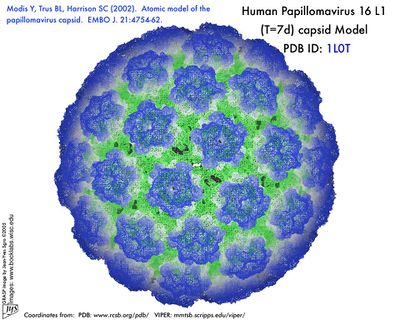Human Papilloma Virus: Difference between revisions
| Line 28: | Line 28: | ||
===Epidemiology=== | ===Epidemiology=== | ||
In 1976, Harald zur Hausen was the first to report and study HPV and its participation in carcinogenesis. It is estimated that, in sexually active populations, HPV is ubiquitous. However, 80 per cent of infections are transitory and removed from the immune system without leaving injury. The other 20 percent may progress to form precursors of genital cancers. The prevalence of HPV infections in the general population are very diverse. The complication of the infection is often determined by the type of HPV contracted. HPV constitutes the most frequent sexually transmitted infection in the world. Epidemiological studies have shown that more than one half of male partners of women with cervical intraepithelial neoplasia (CIN) caused by an HPV infection presented penile lesions. If left untreated, precancerous lesions can evolve into invasive carcinoma. In males, squamous cell carcinoma or carcinoma of the penis constitutes more than 1 percent of all the malignancies in men in developed countries, and from 10 to 20 percent in underdeveloped with an incidence of 0.3-1 per 100,000 men. | |||
ts diagnosis is usually done in the sixth and seventh | |||
decades of life, with a peak of prevalence between 40 and 70 | |||
years-old. It is rare in people circumcised during the neonatal period. | |||
It is estimated that, in sexually active populations, | |||
the virus is ubiquitous, infecting more than 80 percent of the | |||
women of reproductive age. However, 80 per cent of infections | |||
are transitory and removed from the immune system without | |||
leaving injury. There are 20 percent, which may progress to | |||
form precursors of genital cancers. | |||
prevalence of HPV infections in the general population are very | |||
diverse, | |||
f | |||
==Clinical Features== | ==Clinical Features== | ||
===Symptoms=== | ===Symptoms=== | ||
Revision as of 09:11, 26 July 2015

]

]
Etiology/Bacteriology
Taxonomy
|Family = Papillomaviridae
|Genus = Alphapapillomavirus
|species = Human Papillomavirus
NCBI: Taxonomy Genome: Genome
Description
Papillomavirus are small virus with DNA from the family papovavirdae which measure 50 nm in diameter, lack membrane, and their capsids have an icosahedral form composed of 72 capsomeres [3].The DNA of HPV is circular, double chain, and contains approximately 8000 base pairs [3]. Persistent infection by human papilloma virus (HPV) is considered the main causative agent of cervical cancer. According to their oncogenic risk, HPV are classified as low-risk HPV (LR-HPV) or high-risk HPV (HR-HPV) [3]. Classification is based on the origin and degree of homogeneity of the DNA.
Pathogenesis
Transmission
Transmission of HPV occurs most commonly during sexual activity. During sexual activity, micro-trauma or the genital epithelium, particularly in the transformation areas of the cervical epithelium, allows exposure of basal cells to active proliferation of the various types of HPV [3]. The union between receptor of the basal cells with the protein of the HPV infection occurs via direct contact between skin and mucous membranes. Though sexual relationships are the main form of contact, transmission can occur between mother and child during the time of childbirth [3]. In order for infection to develop, the complete virus must be transmitted and not only DNA fragments.
Steps of Pathogenesis
Virulence Factors
The virulence factors of HPV include proteins E6 and E7 that are heavily present in high risk papillomavirus. These proteins have been shown to inactivate the host's tumor suppressor proteins p53 and Rb. This inactivation of tumor suppresser proteins results in the host cells dividing at rate that cannot be regulated. In HR-HPV malignant transformation occurs in the quickly proliferating cells and causing the formation of cervical cancer [4]
Epidemiology
In 1976, Harald zur Hausen was the first to report and study HPV and its participation in carcinogenesis. It is estimated that, in sexually active populations, HPV is ubiquitous. However, 80 per cent of infections are transitory and removed from the immune system without leaving injury. The other 20 percent may progress to form precursors of genital cancers. The prevalence of HPV infections in the general population are very diverse. The complication of the infection is often determined by the type of HPV contracted. HPV constitutes the most frequent sexually transmitted infection in the world. Epidemiological studies have shown that more than one half of male partners of women with cervical intraepithelial neoplasia (CIN) caused by an HPV infection presented penile lesions. If left untreated, precancerous lesions can evolve into invasive carcinoma. In males, squamous cell carcinoma or carcinoma of the penis constitutes more than 1 percent of all the malignancies in men in developed countries, and from 10 to 20 percent in underdeveloped with an incidence of 0.3-1 per 100,000 men.
ts diagnosis is usually done in the sixth and seventh decades of life, with a peak of prevalence between 40 and 70 years-old. It is rare in people circumcised during the neonatal period. It is estimated that, in sexually active populations, the virus is ubiquitous, infecting more than 80 percent of the women of reproductive age. However, 80 per cent of infections are transitory and removed from the immune system without leaving injury. There are 20 percent, which may progress to form precursors of genital cancers. prevalence of HPV infections in the general population are very diverse, f
Clinical Features
Symptoms
Morbidity and Mortality
Diagnosis
Treatment
Prevention
Host Immune Response
Damage Response Framework
References
1. College of Arts and Sciences | The University of Oklahoma. Study Abroad.
2. Virology.wisc.edu. 2002. Atomic Model of papillomavirus capsid.
3. Alba A, Cararach M, Rodriguez-Cerdeira C. 2009. The Human Papillomavirus (HPV) in Human Pathology: Description, Pathogenesis, Oncogenic Role, Epidemiology and Detection Techniques. TODJ 3:90-102.
4.Galinski C. Human Papillomavirus (HPV). Austin Community College.
Created by Hannah Wilson (student of Tyrrell Conway at the University of Oklahoma).
